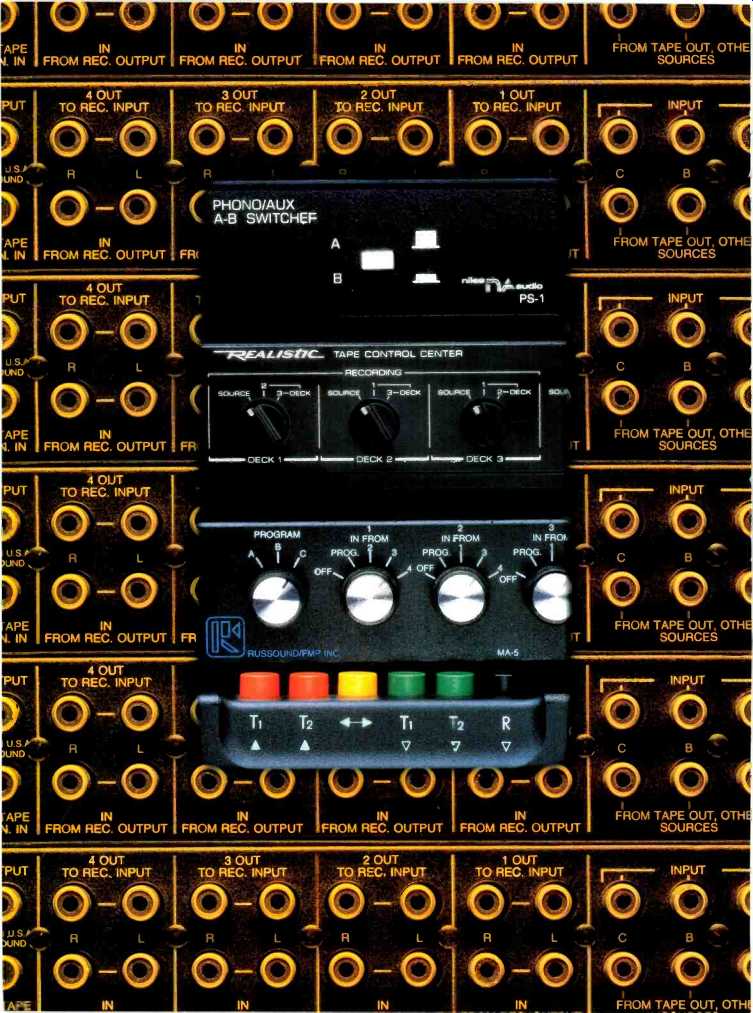
A tape switchbox can handle those extra ins and outs.
by HERMAN BURSTEIN
One frequent problem today is that there aren't enough high-level inputs in receivers, preamps, and integrated amps because of the abundance of high-level signal sources for home audio systems: CD players, tape decks, tuners, laser videodisc players, stereo TVs, VCRs, electronic organs, synthesizers, et al. In the case of tape decks, it is not unusual for an audiophile to have two or more decks of several kinds: Cassette, DAT, open reel, and VCR-either hi-fi analog or digital via an outboard processor.
To solve the problem of insufficient inputs and outputs raised by multiple tape decks, several manufacturers offer tape switchboxes at retail prices varying from about $25 to $200. The ones to which I refer are all passive devices (no electronics). Accounting for the price differences, in addition to pricing policy, are such factors as quality of construction, number of decks that can be accommodated (ranging from three to 10), and refinements such as control of signal level, bridging facilities for adding another switchbox in tandem, and insertion facilities for noise-reduction devices, equalizers, and other signal processors.
The basic and most popular tape switchbox accommodates three decks.
It feeds the audio signal from a receiver, preamp, or integrated amp to the decks--singly or in any desired combination--for recording. At the same time, it feeds the outputs of the decks, singly or in combination, to the receiver for playback. In addition, it permits dubbing from any deck to any other deck, singly or in combination; a monitor switch enables one to listen to the signal being dubbed.
A tape switchbox can also be used to increase the number of high-level inputs for sources other than tape decks. A switchbox intended for three decks can provide as many as six inputs (for a net gain of five inputs, after deducting the system input jack receiving the input from the switchbox), well within the needs of most audiophiles. This is achieved by using both the tape input and tape output jacks of the switchbox as inputs, connecting each of them to the dubbing bus, and putting the "Monitor" switch in its "Copy" position to feed signals from this bus to the receiver. (For those who only need additional high-level inputs, simpler switchboxes, such as DB Systems' DBP-2Y5, are intended for just such a use.) My experience has been with two tape switchboxes, each intended for three decks: Russound/FMP's Model TMS-3 (selling in one New York store for under $60) and Radio Shack's Tape Control Center (selling for about $25). Their circuits are fairly similar. Presumably, the circuits of other switchboxes mainly differ in the number of inputs and outputs they offer (i.e., the number of decks accommodated). To realize the potential of a tape switchbox, it is advisable to fully understand the circuitry of a typical unit; Fig. 1 shows the circuit employed by Russound. For simplicity, it shows only one channel, and for clarity it is a revision of the schematic presented in the TMS3's owner's manual.
The output signal from the receiver's (or preamp's or integrated amp's) tape output jack is fed to the "To Output" jack of the Russound switchbox; it then goes to what we may call a recording bus. From this bus, the incoming signal is fed by recording switches, singly or in combination, to the jacks labeled "Inputs," which feed the signal to the tape decks' inputs. Each recording switch feeds the bus signal to its associated deck when in the "Record" position. The recording switches also have an "Off" position and a "Copy" position for dubbing, which connects the "Inputs" jack to a dubbing bus instead of to the receiver signal. (More about dubbing soon.) he outputs of the decks go, naturally, to the switchbox jacks labeled "Outputs," and via isolating resistors to the playback switches, which feed the outputs singly or in combination to a playback bus. Each playback switch feeds its deck's output to that bus when in the "Play" position. From the playback bus, the signal goes via a "Monitor" switch to the "To Input" jack and then to the tape input of the receiver. This happens provided that the "Monitor" switch is in the "Play" position. If, however, the "Monitor" switch is set to "Copy," the signal at the dubbing bus goes instead to the "To Input" jack and then to the receiver. Each playback switch also has an "Off" position as well as a "Copy" position for dubbing.
When any deck's playback switch is set to "Copy," the deck's output signal goes to the dubbing bus. Setting the recording switches to "Copy" feeds the to-be-dubbed signals at the bus to the decks' inputs for recording. To listen to the signal(s) being dubbed, the "Monitor" switch must be turned to "Copy." The values of the resistors shown are apparently not critical. Russound uses 2.2 kilohms in the TMS-3. An older, almost identical Radio Shack switcher used 3.3 kilohms and added a 2.2kilohm resistor in the "To Output" line; Radio Shack's current switcher has no resistors at all.
I have found two different styles of nomenclature in switchers of this type.
The jacks marked "To Output" and "To Input" on the TMS-3 are, on some units, called "In" and "Out" respectively. This does not imply that either nomenclature is necessarily preferable.
The differences stem from two approaches that seem equally legitimate: Russound views the signal as coming from and going to the receiver and the tape decks, while other companies view the signal as going to and coming from the switchbox.
Another possible source of confusion in the Russound and other switch boxes I've seen is that the signal from the receiver enters the switchbox via jacks located in the bottom row but goes to the tape decks via jacks in the top row. Likewise, the signals from the decks enter the switchbox via jacks in the top row but go from the switchbox to the receiver via jacks in the bottom row. (It may be noted that this anomaly doesn't exist in Russound's Models TMS-5 and TMS-10.) None of this is meant to discourage the reader from using these or other tape switchboxes. It is simply meant to alert you that the user's manual, its schematic, and its hookup diagram should be studied very carefully to discern what goes to what. (If you have a multi-tester, you can use its resistance measuring range if you wish to trace connections.)
To illustrate and flesh out the usefulness of the tape switchbox, I can draw on experience. Some years ago, before receivers (and preamps and integrated amps) began providing accommodations for two decks, I acquired a Russound TMS-3 to connect my Nakamichi cassette and Tandberg open reel decks to my Lafayette KT600 tube preamp. Later, I acquired an NAD 7155 receiver and-temporarily, as it turned out-relegated the preamp and switchbox to the attic because the NAD accommodated two decks and provided bidirectional dubbing. A few years ago, after adding a CD player and stereo TV, I found myself one short of enough high-level inputs. Back down from the attic came the switch box. The outputs of the CD player and stereo TV were connected to two of the Russound's jacks marked "Outputs," the "Monitor" switch was set to "Play," and the "To Input" jack was connected to the receiver's "CD/AUX" jack.
This was not all. I also replaced my old and ailing Thorens TD124 turntable with a Dual CS 5000. I am slowly transferring my 78-rpm phono discs to cassette, and the Dual is one of the extremely small number of turntables today that offers the 78-rpm speed. (I swap my usual cartridge for one with a 78-rpm stylus when doing this.) This project led me to bring the Lafayette preamp back down from the attic. Unlike modern records, with standard RIAA equalization, 78s were made with a variety of equalization characteristics, usually not specified. Happily, the Lafayette has switch-selectable phono equalization, with a choice of four bass-boost and six treble-cut settings for a total of 24 different curves. Moreover, it provides a rumble filter, scratch (treble) filter, and presence control (boost around 3 kHz) that all operate ahead of the preamp's tape output jack. With all these facilities, I can adjust playback equalization by ear to get the best sound from my old discs.
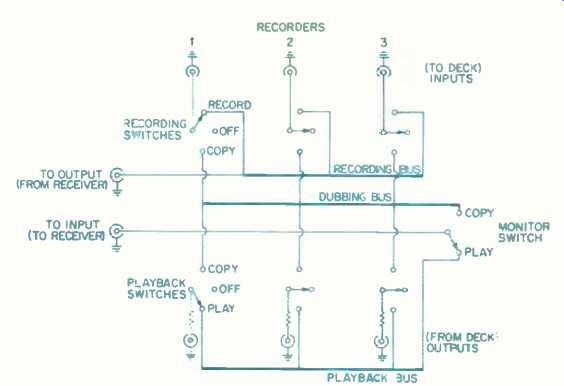
Fig. 1--Circuit of the Russound TMS-3 tape switchbox.
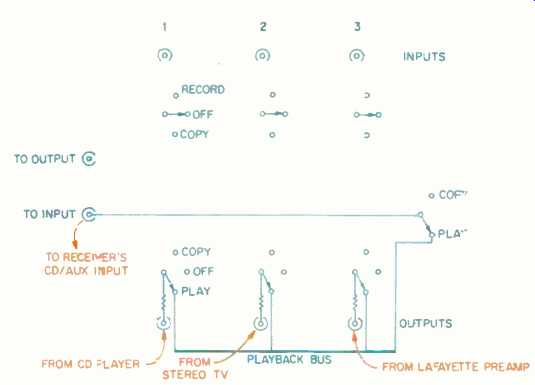
Fig. 2--The switchbox connections and settings now used by the author.
Wiring paths to switchbox elements not in use have been omitted for clarity.)
No significant loading effects have been observed from this arrangement.
To add still more inputs, signals could be fed to the jacks at the top
of the diagram; all switches would then be set to "Copy." See
text.
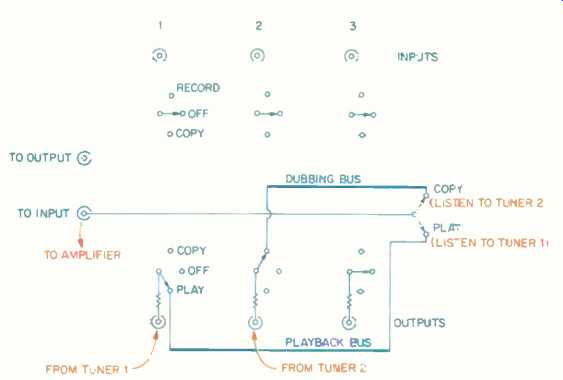
Fig. 3--Connections and settings used to compare two tuners or other high-level
sources.
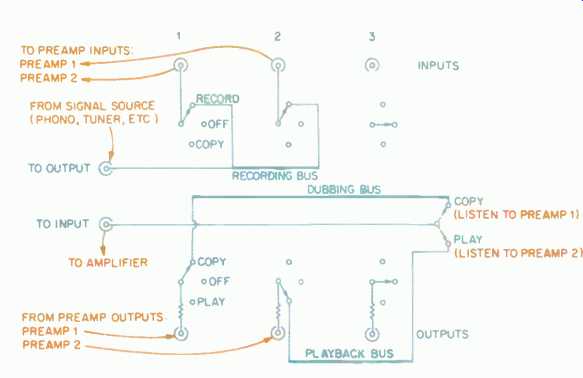
Fig. 4--Connections and settings used for comparison of two preamps. Note
that the recording bus is serving as a Y-connector.
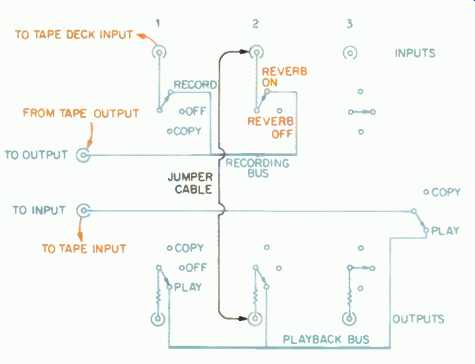
Fig. 5--Connections and settings for obtaining reverb effects from a three-head
tape deck; note the external jumper cable required.
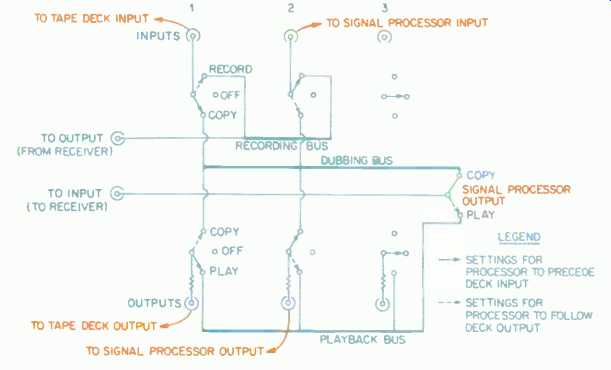
Fig. 6--Using this setup, a signal processor can be used to modify the
signal going to a tape deck in recording (solid arrows) and to modify the
signal coming from the deck in playback (dashed arrows).
For a dubbing session of 78s, I interchange the tonearm headshells containing my two cartridges and transfer the turntable cables from the NAD's phono input to the Lafayette's. The tape output jack of the Lafayette is permanently connected to the third "Outputs" jack of the Russound switchbox.
===============
SWITCHER SOURCES
Canton North America ( 915 Washington Ave. South, Minneapolis, Minn. 55415). Connect 20 switcher, $80, has facilities for two record/play decks and one high-level source via five-pin DIN jacks; allows dubbing from any source to any deck, with volume control for playback.
DB Systems ( Box 460, Rindge Center, N.H. 03461). DBP-2J/5 switch box, $69.95 with nickel-plated jacks or $84.95 with gold-plated jacks, can be used for five sources.
Niles Audio Corp. ( P.O. Box 160818, Miami, Fla. 33116). TSB-3, $79.95, is for three record/play decks, with dubbing between all decks. CPM31, $179.95, has facilities for five record/play decks, with matrix switching permitting copying between all decks. PS-1 phono/AUX A/B switcher, $49.95. AXP-1, $59.95, for five high-level inputs.
QED (c/o May Audio Marketing, P.O. Box 1048, Champlain, N.Y. 12919). TSU2P, $90, for two decks. TSU3P, $110, for three decks; $140 with gold-plated jacks and nonmagnetic casing. IX4, $125, for two tape decks and two line-level inputs; $155 with gold-plated sockets and nonmagnetic casing. PSU, $50, for two turntables.
Radio Shack. Stereo Tape Control Center/Catalog No. 42-2115, $24.95, has facilities for three record/play decks.
Russound/FMP ( 10 Forbes Rd., Newmarket, N.H. 03857). TMS-3, $70, for three record/play decks.
TMS-5, $99, for five record/play decks. TMS-10, $179, for 10 recorders and two processors. SP-1, $199, for four record/play decks, plus signal processors and encode/decode noise reducers via built-in patch-bay. MA-5, $90, for four record/play decks and/or processors, plus three high-level sources, with provisions for daisy chaining recorders and devices in any order. AX-6 input selector, $49, for six high-level sources.
Vanco ( 970 North Shore Dr., Lake Bluff, III. 60044). Information not available at press time.
===============
I leave all three of the switchbox's playback switches in the "Play" position so that the CD player, stereo TV, and Lafayette outputs are always simultaneously connected to the "CD/ AUX" input of the NAD. This is for convenience, to minimize switching. True, the three signal sources mutually load each other and the NAD, but with only a slight and very acceptable reduction in gain and without audible adverse effects with respect to frequency response and distortion. If there were undesirable loading effects, all I'd have to do is set the playback switches for the unused sources to "Off." Figure 2 shows the switchbox connections and settings I now use but omits switchbox wiring to elements not in use, so that the signal path can more easily be followed. To listen to CD, stereo TV, or 78s via the Lafayette preamp, the NAD's selector switch is turned to "CD/AUX." Similarly, to record from any of these, its record switch is turned to "CD/AUX." You may be wondering why I don't use the recording section of the Russound to switch my turntable between the NAD and Lafayette phono inputs. I tried this but encountered excessive hum. I connected the turntable cables to the switchbox via the "To Output" jack and, via the recording switches and "Outputs" jacks, fed the phono signal alternatively to the NAD and the Lafayette. I tried various connecting cables and grounding points for the turntable's ground wire, but hum could not be reduced to my satisfaction. I tried the Radio Shack switchbox but without obtaining noticeably different results. Therefore, the turntable was reconnected directly to the NAD. It should be recognized that the shielding of these two switchboxes is designed only for high-level signals. A low-level signal, such as is produced by a magnetic phono cartridge, requires something like 40 to 60 dB of amplification before matching a high-level signal, so the former is far more susceptible to audible hum pickup. (In voltage terms, the amplification is roughly between 100 and 1,000 times; in power terms, between 10,000 and 1,000,000 times.) On the other hand, there are switchboxes on the market that are designed to accommodate low-level sources, such as Niles Audio's PS-1 and OED's PSU. (Editor's Note: I've found that DB Systems' DBP2J/5 works fine, even with MC cartridges, as long as you keep it clear of strong hum fields.-I.B.) I wasn't too unhappy that I couldn't use my switcher for phono cartridges, because I soon needed another high-level input, this time for an HQ Hi-Fi VCR. Its audio output was fed to one of the Russound's "Inputs" jacks (see Fig. 1). Switches for all jacks in use were turned to "Copy," putting their signals on the dubbing bus; the "Monitor" switch was set to "Copy," feeding the signal on the dubbing bus via the "To Input" jack to the NAD. Additional non-tape roles for the tape switchbox may well be found by the creative audiophile actively involved with audio equipment. To illustrate, Fig. 3 shows the connections one could make to compare two tuners by moving a single switch. Tuner 1 goes to one "Outputs" jack, tuner 2 to another, and the "To Input" jack to the amp (preamp, power amp, or receiver). The "Monitor" switch is moved to "Play" to listen to tuner 1 and to "Copy" to listen to tuner 2.
As a more complex example, Fig. 4 shows how a comparison could be made between two preamps by moving a single switch. The audio signal--from a tuner, CD player, turntable, etc.--is fed to the "To Output" jack, recording switches 1 and 2 are set to "Record," and the corresponding "Inputs" jacks are connected to the inputs of preamps 1 and 2. In brief, this section of the switchbox serves as a Y connector between the source and the two preamps. The preamps' outputs go to the 1 and 2 "Outputs" jacks, playback switch 1 is set to "Copy," playback switch 2 is set to "Play," and the "To Input" jack is connected to the amp. The "Monitor" switch is turned to "Copy" to listen to preamp 1 and to "Play" to listen to preamp 2, or another example of the versatility of the tape switchbox, we return to tape recording. If you have a three-head deck that permits simultaneous recording and playback-as is often the case today-and if you wish to achieve an effect akin to reverberation, Fig. 5 shows the appropriate connections for one deck. The receiver's tape output and input are connected to the switch box's "To Output" and "To Input" jacks, respectively. The deck's input and output jacks are connected to the switchbox's "Inputs" and "Outputs" jacks, respectively, for deck 1. The record and playback switches for decks 1 and 2 are set to "Record" and "Play." The "Monitor" switch is set to "Play." A jumper cable is connected between the "Inputs" and "Outputs" jacks intended for deck 2. The jumper causes the slightly delayed playback signal to be fed back to the input for repeated but steadily diminished recording, resulting in a simulation of reverb. To turn off the reverb, the record switch intended for deck 2 is moved to "Off." My cassette deck is connected as in Fig. 5, using my old Radio Shack switchbox.
The amount of reverb depends or the deck's playback volume. Too little volume produces no audible result, while too much can lead to unpleasant results, including oscillation. Therefore, it is best that the deck have a playback volume control to regulate the reverb.
Further, I find that the reverb can otter be pleasant on music but usually is undesirable on speech.
One final example, Fig. 6, shows how a tape switchbox could provide flexibility in coupling a tape deck with a signal processor (equalizer, imager, compander, single-ended noise reducer, reverb unit, etc.). The switch positions designated by the solid arrows cause the processor to precede the deck's input; those designated by the dashed arrows cause the processor to follow the deck's output.
Thought and experimentation will reveal applications other than those depicted in Fig. 6. To illustrate, assume one employs pre-deck processing and wishes to compare the deck's output with its input signal. Setting the "Monitor" switch to "Copy" will feed the signal processor's output (which is also the deck's input) to the receiver. Moving the switch to "Play" will feed the deck's output to the receiver.
The pair of three-deck, passive tape switchboxes we've discussed are relatively simple; models with much more elaborate facilities are available. Some permit the use of more tape decks and the insertion into the recording chain of encode/decode noise-reduction devices (such as outboard dbx NR units) and of signal processors such as equalizers, imagers, subharmonic synthesizers, reverb devices, single-ended noise reducers, and companders.
The Russound/FMP TMS-10 and the recently discontinued dbx 200XG are examples. Still more elaborate passive switchboxes, such as Russound's SP 1, include patchbays for complex audio hookups.
Considering its usefulness and versatility, and a price well below $100 (unless you opt for an elaborate unit), the tape switchbox belongs in the best-buy category.
(adapted from Audio magazine, Jun. 1989)
= = = =